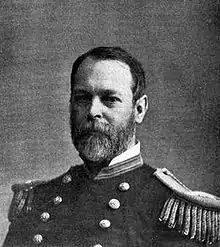William Harkness
William Harkness (December 17, 1837 – February 28, 1903) was an astronomer. He was born at Ecclefechan, Scotland, a son of James (1803–78) and Jane (née Wield)[1] Harkness. His father was a pastor and moved the family to the United States. Harkness served in the military, traveled extensively, and headed research missions developing techniques and equipment for astronomical study.

Harkness died in Jersey City on February 28, 1903, at the age of 65.[2]
Biography
Harkness was educated at Lafayette College (1854–56), graduated from the University of Rochester (1858) where he was a brother of Delta Kappa Epsilon, and studied medicine in New York City. He served as a surgeon in the Union armies during part of the American Civil War. From 1862 to 1865 he was an "aid in astronomy"[3] at the United States Naval Observatory and then, after service on the monitor USS Monadnock (1865–66), was employed in the Hydrographic Office.
During the eclipse of August, 1869, Harkness discovered the coronal line K 1474. Three years later he was made a member of the Transit of Venus Commission,[4] and had charge of the party at Hobart, Tasmania in 1879 and at Washington in 1882, when he became the executive officer. His most memorable accomplishments are related to the construction of telescopes, his theory of the focal curve of achromatic telescopes, and his invention of the spherometer caliper and other astronomical instruments. He was astronomical director of the Naval Observatory (1894–99) and director of the Nautical Almanac (1897–99). He retired from the navy on attaining the relative rank of rear admiral (December, 1899). He was president of the American Association for the Advancement of Science (1893). Of his works, The Solar Parallax and its Related Constants (1891) is the most important.
References
- Hockey, Thomas (2009). The Biographical Encyclopedia of Astronomers. Springer Publishing. ISBN 978-0-387-31022-0. Retrieved August 22, 2012.
- Skinner, A. N. (1903). "William Harkness". Science. 17 (433): 601–602. Bibcode:1903Sci....17..601S. doi:10.1126/science.17.433.601. PMID 17789987.
- Bigelow, Frank H. (1906). "William Harkness". Bulletin of the Philosophical Society of Washington. 14: 292–296.
- Dick, S. J.; Orchinson, W.; Love, T. (1998). "Simon Newcomb, William Harkness and the Nineteenth-century American Transit of Venus Expeditions". JRNL for Hist of Astronomy. 29 (3): 221–255. Bibcode:1998JHA....29..221D. doi:10.1177/002182869802900302. S2CID 117722877.
Further reading
- Dick, Steven J. (2002). Sky and Ocean Joined: The U.S. Naval Observatory 1830–2000. Cambridge University Press. ISBN 0-521-81599-1.- See especially Chapter 7.
- Harkness, William (1883). "Address". Proceedings of the American Association for the Advancement of Science. Salem: 77–88.
- Harkness, William (1888). On the Progress of Science as Exemplified in the Art of Weighing and Measuring. Washington: Judd & Detweiler Company.
On the Progress of Science as Exemplified in the Art of Weighing and Measuring.
External links
- Chasing Venus, Observing the Transits of Venus Smithsonian Institution Libraries
- This article incorporates text from a publication now in the public domain: Gilman, D. C.; Peck, H. T.; Colby, F. M., eds. (1905). New International Encyclopedia (1st ed.). New York: Dodd, Mead. Missing or empty
|title=(help)
